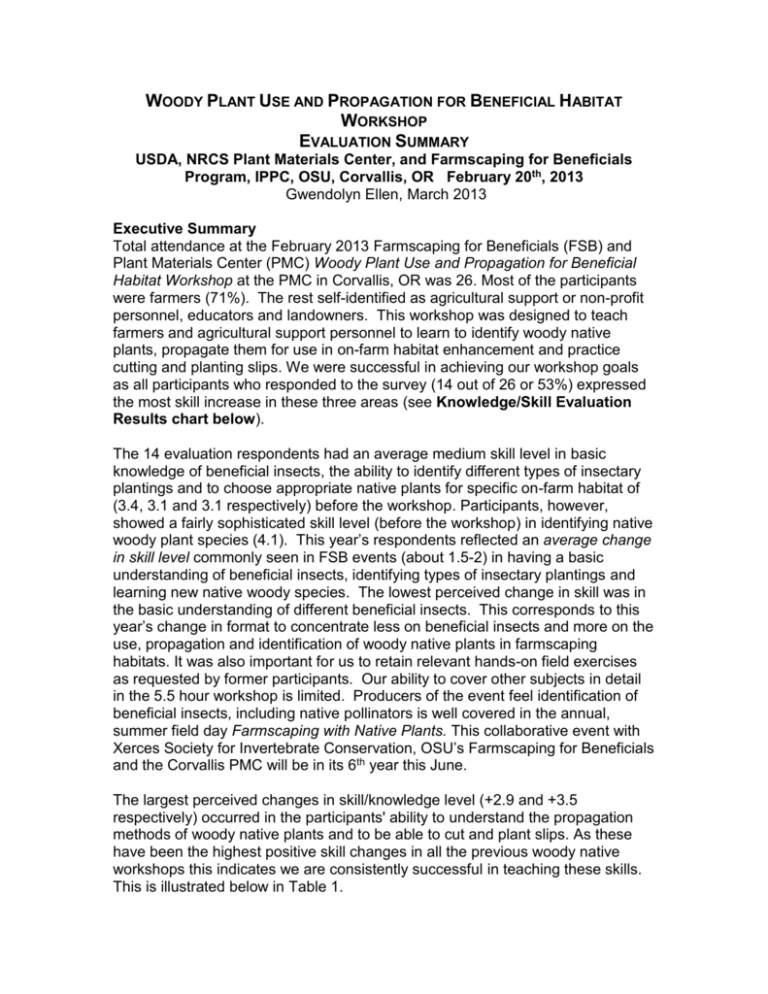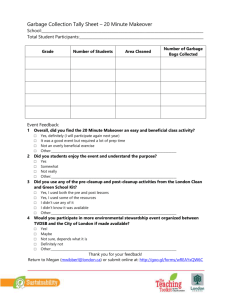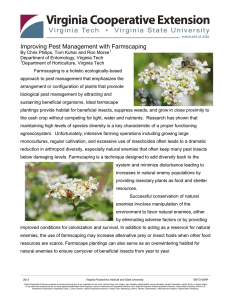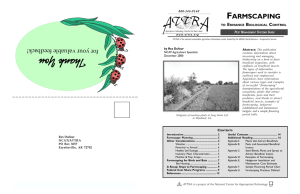Evaluation Summary
advertisement

WOODY PLANT USE AND PROPAGATION FOR BENEFICIAL HABITAT WORKSHOP EVALUATION SUMMARY USDA, NRCS Plant Materials Center, and Farmscaping for Beneficials Program, IPPC, OSU, Corvallis, OR February 20th, 2013 Gwendolyn Ellen, March 2013 Executive Summary Total attendance at the February 2013 Farmscaping for Beneficials (FSB) and Plant Materials Center (PMC) Woody Plant Use and Propagation for Beneficial Habitat Workshop at the PMC in Corvallis, OR was 26. Most of the participants were farmers (71%). The rest self-identified as agricultural support or non-profit personnel, educators and landowners. This workshop was designed to teach farmers and agricultural support personnel to learn to identify woody native plants, propagate them for use in on-farm habitat enhancement and practice cutting and planting slips. We were successful in achieving our workshop goals as all participants who responded to the survey (14 out of 26 or 53%) expressed the most skill increase in these three areas (see Knowledge/Skill Evaluation Results chart below). The 14 evaluation respondents had an average medium skill level in basic knowledge of beneficial insects, the ability to identify different types of insectary plantings and to choose appropriate native plants for specific on-farm habitat of (3.4, 3.1 and 3.1 respectively) before the workshop. Participants, however, showed a fairly sophisticated skill level (before the workshop) in identifying native woody plant species (4.1). This year’s respondents reflected an average change in skill level commonly seen in FSB events (about 1.5-2) in having a basic understanding of beneficial insects, identifying types of insectary plantings and learning new native woody species. The lowest perceived change in skill was in the basic understanding of different beneficial insects. This corresponds to this year’s change in format to concentrate less on beneficial insects and more on the use, propagation and identification of woody native plants in farmscaping habitats. It was also important for us to retain relevant hands-on field exercises as requested by former participants. Our ability to cover other subjects in detail in the 5.5 hour workshop is limited. Producers of the event feel identification of beneficial insects, including native pollinators is well covered in the annual, summer field day Farmscaping with Native Plants. This collaborative event with Xerces Society for Invertebrate Conservation, OSU’s Farmscaping for Beneficials and the Corvallis PMC will be in its 6th year this June. The largest perceived changes in skill/knowledge level (+2.9 and +3.5 respectively) occurred in the participants' ability to understand the propagation methods of woody native plants and to be able to cut and plant slips. As these have been the highest positive skill changes in all the previous woody native workshops this indicates we are consistently successful in teaching these skills. This is illustrated below in Table 1. Knowledge/Skill Evaluation Results Table 1: Average change in skills and abilities. Scale of 1 to 7 (1 = no ability or skill, 7 = very able or skilled) before after ability to: workshop workshop To have a basic understanding of different beneficial insects (n=14) 3.4 5.2 To identify different types of insectary plantings (n=14) 3.1 5.4 To learn new native plant species (n=14) To choose appropriate native plants for onfarm habitats (n=13) To understand the propagation methods of woody native plants (n=14) To be able to cut and plant woody native plant slips (n=14) change +1.8 +2.4 4.1 5.6 +1.5 3.1 5.3 +2.2 2.7 5.6 +2.9 2.4 5.9 +3.5 Note: n values are different from 14 (evaluations returned) due to N/A being selected One hundred percent of the farmer respondents stated that attending the workshop will change what they do to enhance habitat on their farms. Seventyone percent will propagate woody natives and create new habitat for beneficial insects (beetle banks, insectary plantings, flowering cover crops, bee nest boxes, etc.) on their farms. Thirty-six percent will consider landscape ecology in future pest management decisions, and adjust management practices (tillage, mowing, pesticide spraying) to increase beneficial insect populations. Other farmers wrote in that they would do better site preparation, and intercrop planted areas. Another commented here that they now realize how much more beneficial habitat helps on the farm. The two identified agricultural support personnel respondents both stated this workshop will change how they intend to advise clients on farm management practices that support beneficial insects and that they will incorporate beneficial insect habitat enhancement into already existing trainings in farm bill programs. One will advise farmers to adjust management (tillage, mowing, etc.) where possible to increase on-farm beneficial insect populations and one will advise them to create new habitat for beneficial insects (beetle banks, in-field insectary plantings, hedgerows, etc.). Both will advise clients to propagate and use local native plants in on-farm habitat. Ninety-three percent of the respondents expressed that their expectations of the workshop were met or exceeded. It is interesting to note here that three of the respondents requested the workshop be longer to enable more practice in the exercises and to present more information. The workshops have been extended over the years from 3 hours to 5.5 hours. Additional information respondents requested are: more details on identification of beneficial insects, anything we can start or do more of in late winter/early spring, native herbaceous seeds, whole soil tilth, more Q&A time especially for insects, a support website to share pictures and share data, and to present the cons of using natives at certain sites (such as spreading). Other comments include: “The workshop gave me all the tools I need to plan additional native plantings and extend our hedgerow. I wish I had known as much when we started the hedgerow”; “This was a wonderful workshop. I was given an abundance of information that I will be studying for quite a while”; “The charts about bloom time were very helpful”, and “the reference sheets and copies of slide shows with information made it easy to get all the info and able to add extra notes”. Planting slips for a hedgerow









